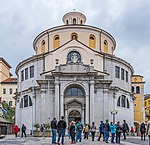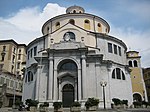Rječina

The Rječina (Italian: Eneo; German: Flaum), also known as the Fiumara, is a river in Croatia that flows into the Adriatic Sea at the city of Rijeka (Italian: Fiume). It is about 18 kilometers (11 mi) long, with an average width of 9 to 16 meters (30 to 52 ft). It springs from a cave at an elevation of 325 meters (1,066 ft) above sea level, below the high cliff of Kičej Hill (elevation 606 meters or 1,988 feet). Until 1870 the river's spring was below the next hill, Podjavorje, but it collapsed in an earthquake near the village of Klana. The most significant confluents are the Sušica, Lužac, Zala, Zahumčica, Golubinka, Ričinica, and Borovšćica, but they are dry for most of the year. In 1968 a dam Valići was built, creating Lake Valići to facilitate a hydroelectric power plant, HE Rijeka, but destroying the village of the same name in the process. The Rječina flows through a canyon for almost half of its length. In Rijeka, the river branches into two parts: Dead Channel (Mrtvi kanal, the old basin), and the new channel, which was created in the 19th century, when Dead Channel was used as a harbor. The best-known sight is the Gaspar Mill (Gašparov mlin) in Martinovo Selo, which was restored in the 1990s. Notable fauna are trout and river crabs.
Excerpt from the Wikipedia article Rječina (License: CC BY-SA 3.0, Authors, Images).Rječina
Šetalište Trinaeste divizije, Grad Rijeka Mjesni odbor Centar-Sušak (Rijeka)
Geographical coordinates (GPS) Address Website Nearby Places Show on map
Geographical coordinates (GPS)
| Latitude | Longitude |
|---|---|
| N 45.322 ° | E 14.4495 ° |
Address
Kontejnerski i RO-RO terminal Brajdica
Šetalište Trinaeste divizije
51103 Grad Rijeka, Mjesni odbor Centar-Sušak (Rijeka)
Croatia
Open on Google Maps








